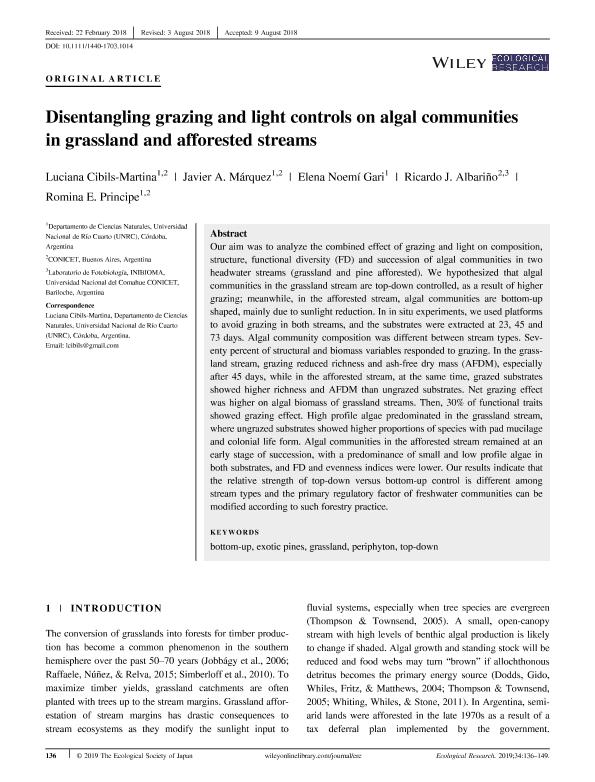Mostrar el registro sencillo del ítem
dc.contributor.author
Cibils Martina, Luciana

dc.contributor.author
Márquez, Javier Andrés

dc.contributor.author
Gari, Elena Noemi

dc.contributor.author
Albariño, Ricardo Javier

dc.contributor.author
Principe, Romina Elizabeth

dc.date.available
2020-07-29T13:19:51Z
dc.date.issued
2019-01-30
dc.identifier.citation
Cibils Martina, Luciana; Márquez, Javier Andrés; Gari, Elena Noemi; Albariño, Ricardo Javier; Principe, Romina Elizabeth; Disentangling grazing and light controls on algal communities in grassland and afforested streams; Springer Tokyo; Ecological Research; 34; 1; 30-1-2019; 136-149
dc.identifier.issn
0912-3814
dc.identifier.uri
http://hdl.handle.net/11336/110512
dc.description.abstract
Our aim was to analyze the combined effect of grazing and light on composition, structure, functional diversity (FD) and succession of algal communities in two headwater streams (grassland and pine afforested). We hypothesized that algal communities in the grassland stream are top-down controlled, as a result of higher grazing; meanwhile, in the afforested stream, algal communities are bottom-up shaped, mainly due to sunlight reduction. In in situ experiments, we used platforms to avoid grazing in both streams, and the substrates were extracted at 23, 45 and 73 days. Algal community composition was different between stream types. Seventy percent of structural and biomass variables responded to grazing. In the grassland stream, grazing reduced richness and ash-free dry mass (AFDM), especially after 45 days, while in the afforested stream, at the same time, grazed substrates showed higher richness and AFDM than ungrazed substrates. Net grazing effect was higher on algal biomass of grassland streams. Then, 30% of functional traits showed grazing effect. High profile algae predominated in the grassland stream, where ungrazed substrates showed higher proportions of species with pad mucilage and colonial life form. Algal communities in the afforested stream remained at an early stage of succession, with a predominance of small and low profile algae in both substrates, and FD and evenness indices were lower. Our results indicate that the relative strength of top-down versus bottom-up control is different among stream types and the primary regulatory factor of freshwater communities can be modified according to such forestry practice.
dc.format
application/pdf
dc.language.iso
eng
dc.publisher
Springer Tokyo

dc.rights
info:eu-repo/semantics/openAccess
dc.rights.uri
https://creativecommons.org/licenses/by-nc-sa/2.5/ar/
dc.subject
BOTTOM-UP
dc.subject
EXOTIC PINES
dc.subject
GRASSLAND
dc.subject
PERIPHYTON
dc.subject
TOP-DOWN
dc.subject.classification
Ecología

dc.subject.classification
Ciencias Biológicas

dc.subject.classification
CIENCIAS NATURALES Y EXACTAS

dc.title
Disentangling grazing and light controls on algal communities in grassland and afforested streams
dc.type
info:eu-repo/semantics/article
dc.type
info:ar-repo/semantics/artículo
dc.type
info:eu-repo/semantics/publishedVersion
dc.date.updated
2020-07-21T21:02:46Z
dc.journal.volume
34
dc.journal.number
1
dc.journal.pagination
136-149
dc.journal.pais
Japón

dc.journal.ciudad
Tokyo
dc.description.fil
Fil: Cibils Martina, Luciana. Universidad Nacional de Río Cuarto. Facultad de Ciencias Exactas, Fisicoquímicas y Naturales. Departamento de Ciencias Naturales; Argentina. Consejo Nacional de Investigaciones Científicas y Técnicas. Centro Científico Tecnológico Conicet - Córdoba; Argentina
dc.description.fil
Fil: Márquez, Javier Andrés. Universidad Nacional de Río Cuarto. Facultad de Ciencias Exactas, Fisicoquímicas y Naturales. Departamento de Ciencias Naturales; Argentina. Consejo Nacional de Investigaciones Científicas y Técnicas. Centro Científico Tecnológico Conicet - Córdoba; Argentina
dc.description.fil
Fil: Gari, Elena Noemi. Universidad Nacional de Río Cuarto. Facultad de Ciencias Exactas, Fisicoquímicas y Naturales. Departamento de Ciencias Naturales; Argentina
dc.description.fil
Fil: Albariño, Ricardo Javier. Universidad Nacional de Río Cuarto. Facultad de Ciencias Exactas, Fisicoquímicas y Naturales. Departamento de Ciencias Naturales; Argentina. Consejo Nacional de Investigaciones Científicas y Técnicas. Centro Científico Tecnológico Conicet - Patagonia Norte. Instituto de Investigaciones en Biodiversidad y Medioambiente. Universidad Nacional del Comahue. Centro Regional Universidad Bariloche. Instituto de Investigaciones en Biodiversidad y Medioambiente; Argentina
dc.description.fil
Fil: Principe, Romina Elizabeth. Universidad Nacional de Río Cuarto. Facultad de Ciencias Exactas, Fisicoquímicas y Naturales. Departamento de Ciencias Naturales; Argentina. Consejo Nacional de Investigaciones Científicas y Técnicas. Centro Científico Tecnológico Conicet - Córdoba; Argentina
dc.journal.title
Ecological Research

dc.relation.alternativeid
info:eu-repo/semantics/altIdentifier/url/https://esj-journals.onlinelibrary.wiley.com/doi/full/10.1111/1440-1703.1014
dc.relation.alternativeid
info:eu-repo/semantics/altIdentifier/doi/http://dx.doi.org/10.1111/1440-1703.1014
Archivos asociados
